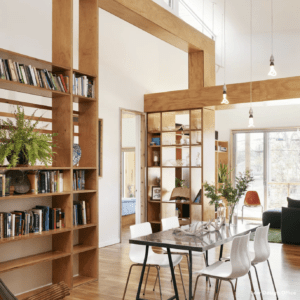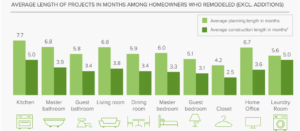(This article was originally published on Houzz.com and has been edited for content and style.)
 While homeowners may be prepared to prioritize certain elements and make sacrifices in others, it can still be a challenge for many to navigate the best choices given their resources. As the experienced designer, they’ll likely look to you for guidance. We’ll discuss common trade-offs that homeowners may face and tips for how to work with clients, make the best use of their resources and help them feel satisfied with the project.
While homeowners may be prepared to prioritize certain elements and make sacrifices in others, it can still be a challenge for many to navigate the best choices given their resources. As the experienced designer, they’ll likely look to you for guidance. We’ll discuss common trade-offs that homeowners may face and tips for how to work with clients, make the best use of their resources and help them feel satisfied with the project.
Balancing budget, time and quality
1. Pick two
Consumers want it all; they want to buy products and services for a great price, with great quality and they want it now. Service providers know that that’s simply not realistic. Lighten the situation by showing this graphic and explaining they can choose two of these options and they will have to trade off the other.

2. Is the homeowner invested?
Many of the trade-offs homeowners must consider in any renovation or design project revolve around the budget. Many want to hire top-notch professionals for high-quality work, but are they prepared for the costs? When a homeowner reaches out to a designer about hiring them for a project, more often than not, the homeowner understands, at some level, the value that working with a professional will bring. However, they may be surprised when they learn what their specific project will actually cost.
Before even getting started, you may have to work with the homeowner to demonstrate why they should hire a professional team instead of doing a DIY project to save money.
To help your potential client understand why you’re worth the higher price tag, share the trade-off to hiring the top-notch pro to work with them:
- The job will be done by skilled tradespeople and likely be professional quality
- The homeowner does not have to do the project themselves
- The client can get a more customized solution
- You can source trade-only products
- You can handle any necessary permits
“Everyone is budget conscious these days. Most clients have unrealistic expectations of what they can get for their money and it’s my job to educate them and manage their expectations. I find most clients will come up with more money if they really, really love the design. So I always throw out ideas and let them know that for an increase in the budget they can have this or that fabulous thing.”
– Jaci Springfield, Springfield Design
3. Comparing cost to value
Once the project is underway, you’ll encounter the specific trade-offs that arise from having a finite budget. To help you best advise the client, ask them to articulate their clear goals for the project so you understand their general priorities.
When it comes time to make decisions about specific elements on a project, ask clients these these questions:
- Will the investment improve your everyday life?
- Will the product solve a pet peeve?
- Will the addition of this element make your house feel like a home?
- Will the purchase increase the value of your home?
Your client may decide the cost of the item is worth the benefit it will bring to their space. Or these questions may help them realize they don’t value the item strongly enough and are willing to let it go entirely or perhaps select something more budget-friendly.
“In my experience, it is essential to walk the client through each potential trade-off and option available as they occur before they make a decision. This gives them a clearer picture of how to best utilize the available resources while still adhering to their remodeling goals.”
Talha Gursoy, Boss Design Center
4. Worth the wait to start
For some homeowners, the trade-off is time. Chances are, they’ve already waited to take on the project before reaching out to you. Our Houzz & Home Study shows the top trigger for undertaking a renovation project is “wanting to do it all along and finally having the means” with 57% of renovating homeowners sharing this sentiment. Homeowners feel they have waited to start the project until they saved the funds to do so.
However, you may still encounter a client whose wishlist goes beyond what their funds can allow. In this case, let them know that they have two options. One option is to trade off the scope and/or quality of materials to fit within the budget they presented and get the project underway. The alternative is to continue to trade off time, which will allow them to arrange the additional funds necessary to get the scope or quality of materials they want.
After the homeowner receives the quoted cost for their project, then they can make decisions regarding how to arrange finances to meet that number.
5. Accommodating the project timeframe
A second consideration related to time is the speed of the project. Our Houzz & Home Study found the combined time for researching and construction is between eight to 12 months for most interior renovation projects. Understandably, homeowners want to enjoy their newly improved space as soon as possible and minimize time living in the disruption of a construction zone.
If speed is a homeowner’s priority, they may be inclined to spend more to have things expedited, or go for the more expensive product or material because it’s in stock. If pressed by a specific timeframe, your client may be willing to trade-off quality by making selections that are in-stock rather than waiting for custom or made-to-order pieces to arrive. During the initial meeting, ask the homeowner if they’re willing to wait to get custom pieces or custom work done or if they want to work with what’s available. You may also need to educate homeowners about how long the project can really take and be prepared to reframe their expectations.
“The in-stock choice over a product that has to be ordered is always one to regret. That gets magnified quickly when it is a predominant design element like a backsplash, appliance or light fixture over an island or, honestly, anything involving a focal point. I would rather see a client put off a project completely than settle for something just because you can get it faster. Pre-planning is never too early. If you want a remodel for Thanksgiving’s get-together, early spring planning can fit the bill as an example. There are lead times to consider, time to make revisions, as well as getting into the contractor’s schedule.”
Wendy Jilek, Colorado Kitchen & Bath
6. Consider material quality
To work with homeowners when it comes to the trade-off of quality, ask them their thought process for selecting the specific items on their wishlist. Perhaps it is a functional issue where it makes sense to implement that specific item. But in some cases, the client may be naming the materials or brand names they are coming across in their research without understanding all of their options, and you both may find another material will meet their needs and look great, too. Once you understand the homeowner’s deeper motivations, you’ll be able to make recommendations that meet the right balance of quality, budget and availability.
“Most frequently, the trade-off is first material quality then scope by a narrow margin. Usually, we price out a high and a low option, so we can make choices along the way. In my projects, we usually splurge on things like appliances and save on things like tile, or we splurge on the sofa and save on the curtains or area rug. I believe that the things we use the most and/or sit on or that touch our skin should be of better quality.”
Brigid Wethington, B. Chic Interiors
Make trade-offs based on usage
1. How will the space be used?
How a client will use their space both now and in the future is one of the top factors impacting the scope and design of a project. The following questions may be able to help prioritize aspects of the project and reveal which choices a homeowner might be inclined to make:
- How do you use the space now?
- How would you like to use it after the project and why?
- What changes do you want to make to the space and why?
- How many people does the space need to accommodate on a normal day?
- How many people does the space need to accommodate at a maximum?
- Will there be any changes that impact how the space will be used in the future?
- Will there be any changes in household size or new pets?
2. Be realistic about the usage
New projects may inspire new dreams; perhaps to be tidier, cook more meals from scratch or spend more time outdoors. Some clients may incorporate these lifestyle changes once they have a more functional space or have more pride in their home, while other clients will continue to fall into the same habits.
Being realistic about what can and will change because of the renovation or redesign is a way to help homeowners make decisions. Ask them what habits or lifestyle changes they plan to make, if any, and present options that fit their current habits and any future aspirations. Being prepared with realistic options can show clients you are thinking about their short-term desires as well as their long-term satisfaction with their project.
“In the midst and excitement of designing the kitchen, it’s easy to get carried away with the fantasy of your idealized persona and to think that a new kitchen will change lifelong habits. I’ve always found it best to understand the true habits and personality of each client. In the end the client is appreciative of this.”
Gemini Watanabe, Summit Street Design
